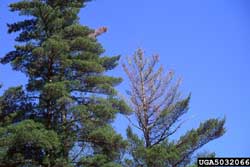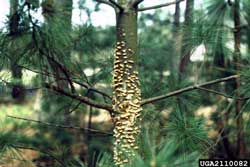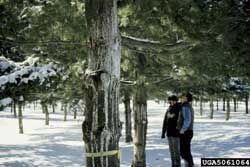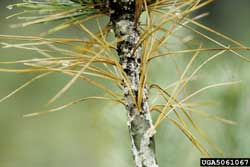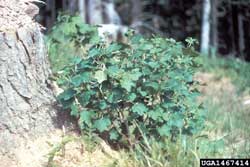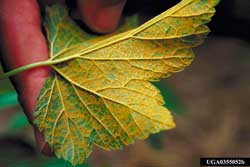White Pine Blister Rust—Cronartium ribicola
White pine blister rust, caused by the fungus Cronartium ribicola, was introduced into the U.S. around 1900 and has since spread throughout the range of white pine. This disease causes mortality and severely reduces the commercial value of eastern white pine (Pinus strobus). The rust fungus cannot spread from pine to pine but requires an alternate host, Ribes species, (currants and gooseberries, collectively called “ribes”), to complete the disease cycle.
Planting or possession of European black currant, Ribes nigrum, or its varieties or hybrids anywhere within the boundaries of the State of Maine is prohibited. The sale, transportation, further planting or possession of plants of other species in the genus Ribes (commonly known as currants and gooseberries, including cultivated wild, or ornamental sorts) is prohibited in all of the following counties: York, Cumberland, Androscoggin, Kennebec, Sagadahoc, Lincoln, Knox, Waldo, Hancock, and parts of Oxford, Franklin, Somerset, Piscataquis, Penobscot, Aroostook, and Washington (quarantine map). This quarantine is administered by the Forest Health & Monitoring Division of the Maine Forest Service,phone: (207) 287-2431 or (207) 287-2791 (see below for links).
Click on images to view full-size
Identification and Control Information
- White Pine Blister Rust on Currants and Gooseberries (PDF)—The Ohio State University Extension
- White Pine Blister Rust—Maine Forest Service
- White Pine Blister Rust Quarantine—Maine Forest Service
- White Pine Rust Fact Sheet—Penn State University
- White Pine Blister Rust Infection Incidence for Selected Areas of New Hampshire (PDF)—New Hampshire Division of Forest and Lands Department of Resources and Economic Development
- After a Century, White Pine Blister Rust Still a Factor (PDF)—USDA Forest Service
More Information
- Maine Forest Service: Conditions Reports (updated regularly) including annual summary reports
[Photos, left to right: Joseph O'Brien, USDA Forest Service, Bugwood.org; Frantisek Soukup, Bugwood.org; Joseph O'Brien, USDA Forest Service, Bugwood.org; Joseph O'Brien, USDA Forest Service, Bugwood.org; USDA Forest Service - Ogden Archive, USDA Forest Service, Bugwood.org; Robert L. Anderson, USDA Forest Service, Bugwood.org]
